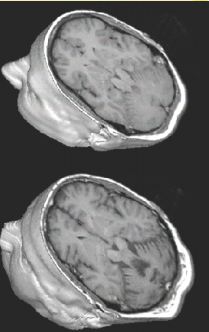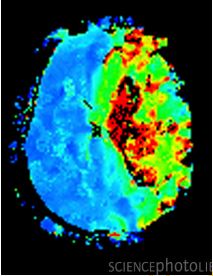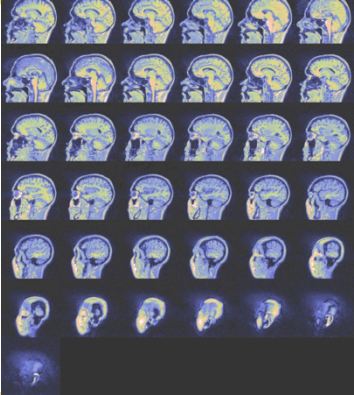| Line 53: | Line 53: | ||
[[Image:intro_fig2.jpeg|400px|thumb|left|Fig 2: fMRI scan of a brain after a stroke. Blues and greens correspond to normal blood flow, reds and blacks correspond to abnormal blood flow.]] | [[Image:intro_fig2.jpeg|400px|thumb|left|Fig 2: fMRI scan of a brain after a stroke. Blues and greens correspond to normal blood flow, reds and blacks correspond to abnormal blood flow.]] | ||
| − | It is important to realize that CT, PET and MRI are three-dimensional imaging modalities and must be visualized in voxels. Figure 3 illustrates how an MRI scan produces multiple slices to build up a representation of a three-dimensional volume | + | |
| + | It is important to realize that CT, PET and MRI are three-dimensional imaging modalities and must be visualized in voxels. Figure 3 illustrates how an MRI scan produces multiple slices to build up a representation of a three-dimensional volume. | ||
[[Image:intro_fig3.jpeg|400px|thumb|left|Fig 3: MRI scan of one half of one hemisphere of the brain]] | [[Image:intro_fig3.jpeg|400px|thumb|left|Fig 3: MRI scan of one half of one hemisphere of the brain]] | ||
| + | |||
| + | |||
| + | Classical chest X-rays on the other hand, are two-dimensional and built up of pixels. When you look at a planar chest X-ray, you see the image of the heart, the lungs, the rib cage and the vertebrae superimposed on one another. This makes accurate diagnosis difficult. | ||
Revision as of 16:18, 4 May 2013
The Bouman Lectures on Image Processing
A sLecture by Maliha Hossain
Subtopic 1: Intro to Tomographic Reconstruction
© 2013
Excerpt from Prof. Bouman's Lecture
Accompanying Lecture Notes
Tomography refers to the method of producing images of plane sections, or slices of a solid object. The word is derived from Greek tomos meaning section.
At this point let me introduce a few common medical imaging modalities:
- Anatomical Imaging Modalities
- Chest X-ray
- Computed Tomography (CT)
- Magnetic Resonance Imaging (MRI)
- Functional Imaging Modalities
- Signal Photon Emission Tomography (SPECT)
- Positron Emission Tomography (PET)
- Functional Magnetic Resonance Imaging (fMRI)
Anatomical imaging modalities only reveal the structure of an object, Figure 1, for example, compares MRI scans of two patients. Functional imaging modalities can differentiate between active and inactive cells. So they can sort of tell you what the tissue is doing. Figure 2 shows an fMRI scan of a woman's brain after a stroke.
It is important to realize that CT, PET and MRI are three-dimensional imaging modalities and must be visualized in voxels. Figure 3 illustrates how an MRI scan produces multiple slices to build up a representation of a three-dimensional volume.
Classical chest X-rays on the other hand, are two-dimensional and built up of pixels. When you look at a planar chest X-ray, you see the image of the heart, the lungs, the rib cage and the vertebrae superimposed on one another. This makes accurate diagnosis difficult.




